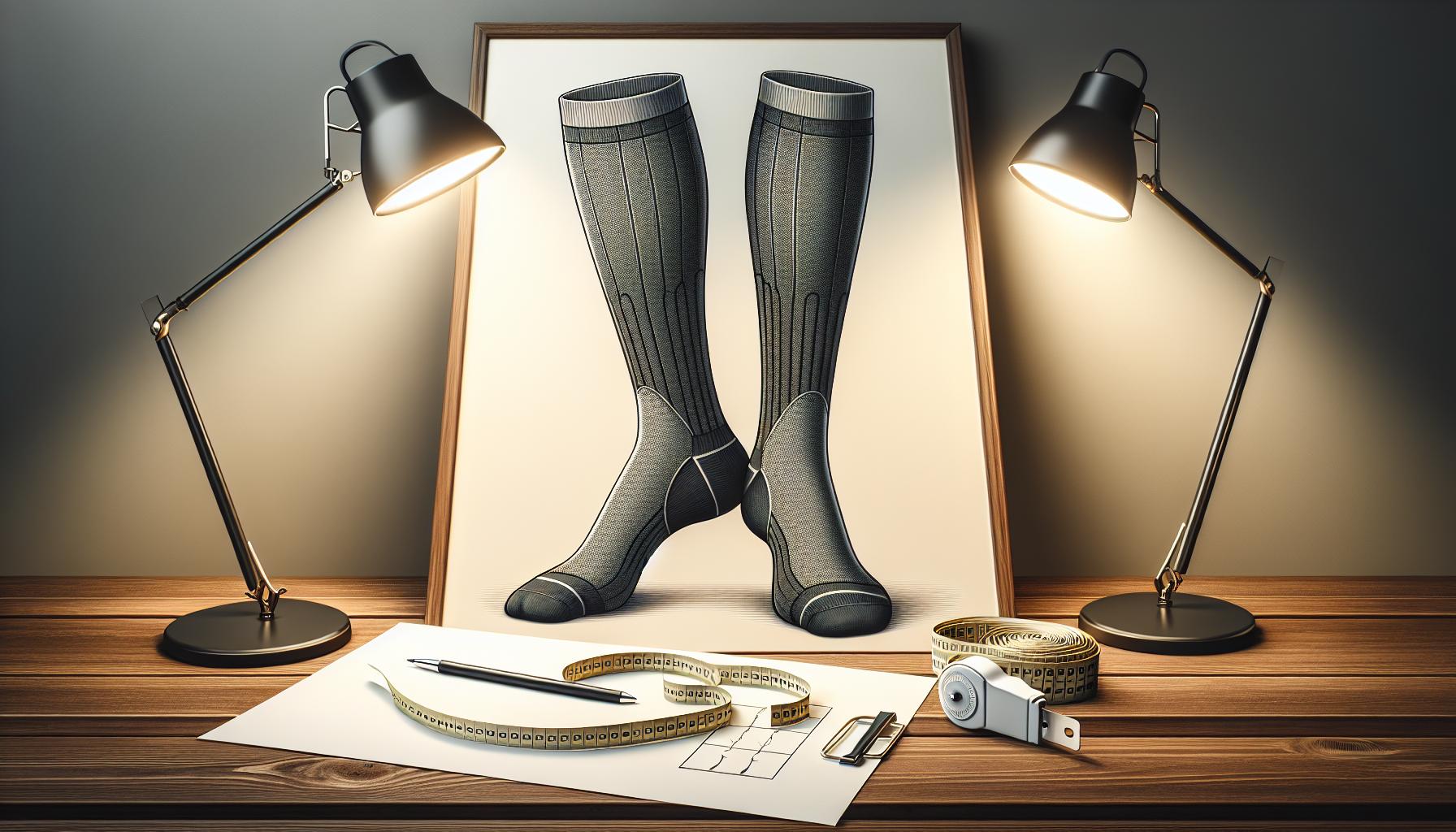Foot pain can be a real struggle, whether it’s from long hours on your feet, a medical condition, or post-workout soreness. I’ve often wondered if simple solutions like compression socks could make a difference. They’re everywhere now, promising relief and better circulation, but do they really live up to the hype?
From athletes to nurses, people swear by compression socks for easing discomfort and improving recovery. But understanding how they work and whether they’re right for your specific needs is key. Let’s dive into what makes these snug-fitting socks so popular and whether they can truly help with foot pain.
What Are Compression Socks?
Compression socks apply gentle pressure to the legs and feet, designed to improve blood flow and reduce discomfort. They usually consist of elastic materials like spandex or nylon, which create a snug fit around the lower limb. These socks come in various lengths, such as knee-high and thigh-high versions, to address different user preferences and conditions.
Graduated compression is often a key feature, with the highest pressure at the ankle and gradually decreasing as it moves up the leg. This design supports circulation by assisting the veins in pushing blood toward the heart, minimizing swelling or fatigue. Medical-grade and non-medical options are available, categorized by compression levels measured in millimeters of mercury (mmHg).
People often use compression socks for specific purposes, including managing varicose veins, preventing deep vein thrombosis, or enhancing recovery after physical activities. Sports-related designs, for instance, target athletes engaged in running or cycling, while travel-specific versions aim to alleviate swelling during long flights. Different styles and colors ensure they’re functional yet versatile for daily wear and professional use.
How Compression Socks Work

Compression socks apply controlled pressure to the legs and feet, aiding blood flow and potentially alleviating foot pain. Their effectiveness lies in their design and materials, which work together to improve circulation and reduce strain.
Mechanism Behind Compression
Graduated compression, a common feature, applies the most pressure at the ankle, gradually lessening higher up the leg. This gradient helps push blood back toward the heart, preventing pooling in the feet. Enhanced circulation reduces swelling and soothes discomfort caused by poor blood flow or extended periods of standing.
Elastic fibers like nylon or spandex provide the necessary tension to compress layers of tissue and veins. With reduced vein diameter, blood flows more efficiently, boosting oxygen delivery to lower limb muscles and minimizing fatigue and soreness. This mechanism also supports quicker recovery after physical activities or minor injuries.
Types Of Compression Socks
Compression socks come in three primary categories: graduated, anti-embolism, and non-medical support.
- Graduated Compression Socks: Designed for mobility, these are ideal for daily use or post-exercise recovery. They target circulation in active individuals with pressure concentrated at the ankles.
- Anti-Embolism Socks: Crafted for bedridden patients, these reduce blood clot risks by maintaining adequate circulation despite limited movement.
- Non-Medical Support Socks: Available over-the-counter, these address mild swelling or discomfort. They’re popular for occasional use and are often less snug than medical-grade options.
Each type varies in compression levels, typically measured in millimeters of mercury (mmHg), with light (8-15 mmHg) to firm (20-30+ mmHg) pressure ratings. Selecting the correct type supports better relief and ensures proper functionality.
Can Compression Socks Help With Foot Pain?

Compression socks can support foot pain relief when used correctly. Their targeted pressure promotes circulation and reduces swelling, factors often linked to discomfort in the feet.
Benefits Of Compression Socks For Foot Pain
Compression socks offer several benefits to address foot pain effectively:
- Enhanced Circulation: Graduated compression improves blood flow, decreasing fluid buildup and relieving pain caused by poor circulation or swollen feet.
- Reduced Swelling: These socks minimize edema, especially after extended standing, sitting, or physical activity.
- Muscle Support: Gentle pressure stabilizes muscles and reduces fatigue, offering relief for soreness or overuse-related discomfort.
- Improved Recovery: By eliminating lactic acid buildup, compression socks aid in faster recovery post-exercise, reducing pain from strained muscles.
For example, individuals experiencing pain from plantar fasciitis or general foot fatigue may feel significant reduction in discomfort with consistent use.
Conditions That May Improve With Compression Socks
Specific conditions leading to foot pain can benefit from compression socks:
- Plantar Fasciitis: Sustained pressure may ease inflammation along the foot’s arch caused by plantar fasciitis.
- Edema: Socks help manage mild to moderate swelling in feet due to pregnancy, injury, or post-surgery.
- Diabetic Foot Pain: Diabetic individuals with circulation issues may find relief through improved blood flow.
- Arthritis-Related Discomfort: Compression reduces joint and tissue swelling resulting from arthritis.
- Post-Workout Fatigue: Athletes recovering after intense training or competitions rely on these socks to decrease soreness.
For every condition, selecting the right compression level—from light (15-20 mmHg) to moderate (20-30 mmHg)—ensures optimal relief.
Limitations And Risks Of Compression Socks

Compression socks offer various benefits, but they’re not without drawbacks. Misuse or improper selection can lead to potential issues.
Potential Downsides
Improper fit can cause discomfort. Compression socks that are too tight may restrict blood flow rather than improving it, potentially leading to numbness or irritation. Similarly, if they’re too loose, they won’t provide the necessary support or pressure.
Skin irritation or allergic reactions may occur. Materials like spandex or nylon in compression socks could irritate sensitive skin or trigger allergies in individuals prone to such conditions.
Prolonged wear carries risks. Wearing them for extended periods, especially when not recommended, may result in skin damage, bruising, or even impaired circulation.
Certain conditions contraindicate use. Individuals with severe peripheral artery disease, congestive heart failure, or skin infections should avoid compression socks unless guided by a healthcare professional.
When To Consult A Doctor
Severe medical conditions require professional advice. If someone experiences chronic foot pain due to underlying health issues, guidance on proper compression levels or alternative therapies is essential.
Unusual symptoms after use indicate the need for consultation. Swelling, discoloration, or sharp pain while wearing compression socks may signal improper use or an undiagnosed health issue.
Customized solutions may be necessary. For those with specific needs, such as post-surgery recovery or diabetic foot care, a doctor’s recommendation ensures effective and safe use of compression socks.
Choosing The Right Compression Socks For Foot Pain

Selecting the right compression socks is essential for alleviating foot pain effectively. Knowing what to look for ensures better comfort and optimal benefits.
Factors To Consider
Compression level matters when addressing foot pain. Socks are available in light (15-20 mmHg), moderate (20-30 mmHg), and firm (30-40 mmHg) options. For mild swelling or general discomfort, light to moderate levels work; firm levels suit severe conditions like chronic pain or after-surgery recovery.
Material impacts comfort and durability. Look for socks made of breathable fabrics like nylon or spandex, which support elasticity and moisture-wicking. Hypoallergenic materials may be better for sensitive skin.
Fit ensures effectiveness. Compression socks must snugly contour your feet without being overly tight, as improper sizing can either reduce effectiveness or worsen circulation issues. Measure your ankle, calf, and foot length against the manufacturer’s sizing chart.
Length affects targeted support. Knee-high socks are common for mobility and foot pain, while thigh-high options cater to advanced circulation needs. Crew-length selections suit specific activities like hiking or running.
Proper Usage And Care
Using compression socks correctly prolongs their benefits. Wear them in the morning, as blood pooling is typically minimal upon waking. Limit wearing time to 6-8 hours unless instructed otherwise by a healthcare provider.
Follow care instructions to maintain elasticity and hygiene. Hand washing with mild detergent preserves the fabric’s properties, though machine washing on delicate cycles is acceptable for some brands. Avoid using fabric softeners or exposing the socks to high heat, which can damage their compression functionality.
Replace worn pairs every 3-6 months to ensure consistent performance. Signs of wear include loosening elasticity, uneven compression, or material thinning.
Conclusion
Compression socks can be a helpful tool for managing foot pain, but they’re not a one-size-fits-all solution. Their ability to improve circulation, reduce swelling, and provide support makes them a popular choice for many. However, it’s essential to choose the right compression level, fit, and style to ensure they’re effective and comfortable.
If you’re dealing with persistent foot pain or have specific medical conditions, consulting a healthcare professional is always a smart move. By understanding your needs and using compression socks correctly, you can take a step toward better foot health and overall comfort.
Frequently Asked Questions
What are compression socks, and how do they work?
Compression socks are specialized stockings made from elastic materials like spandex or nylon. They apply controlled pressure to the legs, with the highest pressure at the ankle, which gradually lessens further up the leg. This design improves blood flow, reduces swelling, and alleviates discomfort caused by extended standing, poor circulation, or certain medical conditions.
Can compression socks help relieve foot pain?
Yes, compression socks can help reduce foot pain by improving circulation, minimizing swelling, and providing muscle support. They are particularly beneficial for conditions like plantar fasciitis, edema, and arthritis-related discomfort. However, their effectiveness depends on proper fit and compression level.
What conditions can compression socks help with?
Compression socks can help manage plantar fasciitis, varicose veins, edema, diabetic foot pain, arthritis-related pain, and post-exercise fatigue. They are also used to prevent deep vein thrombosis and improve recovery after intense physical activity.
How do I choose the right compression socks for foot pain?
To choose the right compression socks, consider your specific condition, the desired compression level (measured in mmHg), and the appropriate sock length. Light compression (15-20 mmHg) suits mild issues, while moderate compression (20-30 mmHg) is suitable for more severe discomfort.
Can I wear compression socks all day?
Compression socks can be worn during the day, especially if you are on your feet for long hours. However, wearing them overnight is not generally recommended unless prescribed by a doctor. Proper sizing and breaks are important to avoid discomfort or circulation issues.
Are there any risks or side effects of using compression socks?
Improperly fitted compression socks may cause discomfort, restricted blood flow, or skin irritation. Prolonged use can potentially lead to skin damage. People with severe peripheral artery disease or congestive heart failure should consult a doctor before use.
What types of compression socks are available?
There are three primary types: graduated compression socks for daily use, anti-embolism socks for patients at risk of blood clots, and non-medical support socks for mild swelling or pain. They differ in compression levels and intended purposes.
How do I care for my compression socks?
To maintain compression socks, wash them regularly with mild detergent and air dry to preserve elasticity. Avoid using high heat or harsh chemicals. Replace them every 3-6 months to ensure consistent performance and effectiveness.
Do compression socks help with plantar fasciitis?
Yes, compression socks can help relieve plantar fasciitis by improving blood flow, providing support, and reducing inflammation in the affected area. Opt for socks with moderate compression and ensure a proper fit for optimal relief.
Should I consult a doctor before using compression socks?
If you have chronic foot pain or medical conditions like artery disease or heart issues, consult a doctor before using compression socks. Professional advice ensures you choose the correct compression level and avoid potential complications.
